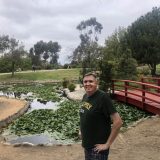“Paso por aqui, el adelantado Don Juan de Oñate, del descubrimiento de la mar del sur a 16 de Abril de 1605.”
Translated, the inscription proclaims: “Passed by here, the expedition leader Don Juan de Oñate, from the discovery of the Sea of the South the 16th of April of 1605.”
While Oñate’s inscription is the oldest Spanish carving found on El Morro, he was not the first Spaniard to see the mesa. In March 1583, Diego Pérez de Luxan, chronicler of an exploring expedition led by Antonio de Espejo, recorded in his journal that the party had camped at a location he called El Estanque de Peñol (The Place at the Great Rock).
However, no record of the expedition’s passing has been found on the mesa.
People had been carving messages on Inscription Rock in the high desert of northwestern New Mexico for centuries before de Oñate, the first Spanish Conquistador to organize a colony in New Mexico, came along.
The Spanish reigned in New Mexico for nearly 200 years. After being driven out by the Pueblo Rebellion of 1680, they took back control twelve years later and ruled for generations.
General de Vargas recorded his victory in this way:
“Here was the General Don Diego de Vargas, who conquered for our Holy Faith and for the Royal Crown all of New Mexico at his own expense, year of 1692.”

Rising 200 feet above the valley floor, El Morro’s Inscription Rock bears witness to over 700 years of history. © Rex Vogel, all rights reserved
The final inscription in Spanish was dated 1774. The Spanish lost control of their North American territories to the Mexicans who in turn lost them to the United States during the Mexican-American War of the 1840s.
At the close of the Mexican War in 1848, New Mexico became a U.S. territory, and the arrival of the Americans opened a new chapter in El Moro’s long history.
In 1849, Lt. James Simpson, an Army topographical engineer, and Richard Kern, an artist, were the first Americans to carve their names on El Morro. More significantly, however, Kern sketched many of the inscriptions and brought them to national attention.
After Simpson and Kern, many American wagon trains carrying emigrants to California passed and, as the Anasazi and Spaniards did before them, they left a record of their presence.
On a daytrip from Sky Casino RV Park, we visited El Morro National Monument. El Morro is Spanish for headland or bluff.
Rising 200 feet above the valley floor, El Morro’s Inscription Rock bears witness to over 700 years of history. Drawn here by its secluded spring–fed water hole, Anasazi/Zuni traders, Spanish Conquistadores, and Anglo cultures marked their passing by carving 2,000 petroglyphs and inscriptions on Inscription Rock, a soft sandstone monolith.
The main thing to see is Inscription Loop Trail, a half mile walk past numerous Spanish and Anglo inscriptions, as well as pre–historic petroglyphs.

Drawn here by its secluded spring–fed water hole, Anasazi/Zuni traders, Spanish Conquistadores, and Anglo cultures marked their passing by carving 2,000 petroglyphs and inscriptions on Inscription Rock, a soft sandstone monolith. © Rex Vogel, all rights reserved
Before venturing out be sure to view the short informative film in the visitor center and pick up a copy of the trail guide to assist you in spotting and understanding the various inscriptions.
You can continue your walk up to the top of the mesa for some great views and to see the partially-excavated ruins of an Ancestral Puebloan village.
Did You Know?
El Morro National Monument’s avian claim to fame is the White-throated Swift, which was described to science for the very first time here in 1851, by Dr. S. W. Woodhouse of the Sitgreaves Expedition.
El Morro National Monument
Details
Operating Hours: Open year-round, 24 hours a day
Admission: Fee free
Elevation: 7,219 feet
Location: From I-40 west of Grants, take Exit 81 south on Highway 53 for 42 miles to El Morro National Monument.
Camping: NO camping facilities
Address: HC 61 Box 43, Ramah, NM 87321
Contact: (505) 783-4226
Website: nps.gov/elmo
For information about RV parks and campgrounds in New Mexico, check out Good Sam RV Travel Guide and Campground Directory.
Worth Pondering…
I am part of all that I have met
Yet all experience is an arch wherethro
Gleams that untravell’d world, whose margin fades
Forever and forever when I move.
—Alfred Lord Tennyson
You May Also Like
- ADK Packworks Introduces The Grocer Reusable Bag
- LIFESTYLE RV Introduces LS38R Floor Plan
- Jayco Introduces Precept Gas Class A Motorhome
- Airstream Transformed into Doom Bar
- Iowa Hides RV Registration Fee Tax Grab in Catch-All Bill
If you enjoy these articles and want to read more on RV travels and lifestyle, visit my website: Vogel Talks RVing.









Jim Sweeney
We've been there, and it was really neat. And right down the road is Bandera Volcano and the Ice Caves….also worth stopping to see.
Chris Winter
Considerd graffiti anywhere else today and any attempt to make your mark here is a felony!